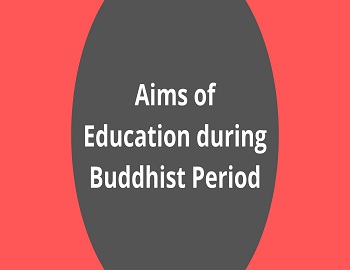Aims of Education during Buddhist Period:
(1) Development of Human Qualities- The main aim of education during the Buddhist period was the development of human qualities in the life of society. It stood for the inculcation of the feeling of world brotherhood in human beings. The education of those days was aimed at ignoring the communal and sectarian feelings and freeing human beings from all worldly distress and troubles.
(2) Purity of Behaviour- Education in this age kept an eye on the mental development of the students as well as on the piety and purity of their day to day behaviour and etiquette. It was then believed that only a man of pious behaviour can serve his nation in its progress and prosperity as well as bring about the development of his own personality.
(3) Obedience to Religion- Religion occupied the place of priority in Buddhist education also. Therefore, students took lessons of obedience to religion. A Chinese traveller who visited India in that period has, while mentioning the qualities of Nalanda Universities, remarked that “Buddhist education was based on the association of life and religion”.
(4) Development of Power of Reasoning- In those days students were given an opportunity to put questions to teachers in order to clarify things and to remove their doubt. There used to be debates and discussions on different topics. Every student was independent to apply his ability of argumentation. Thus they were able to remove their doubts and develop the power of reasoning.
(5) Education through Travelling- Followers of Buddhism used to propagate their religion by travelling in different parts of the country and world. Many renowned teachers of this age assisted in the spread of education. Acharya Anirudha and Mahamudgalayan were distinguished personalities among them. Thus, travelling was the best way to educate students with real and practical knowledge of life.
(6) Self-Restraint and Building of Character- Education, during this age, put much stress on self-restraint and character. Students had to become “Bhikshus” (beggar). They were kept aloof from luxurious life. They could not use perfumed oil, could not wear long hair and were advised to lead a life of piety and good conduct. To speak the truth and to follow non-violence were the main teachings.
(7) All-Round Development- During the Buddhist period, education did not aim at mental and spiritual development only, but much importance was also attached to physical and aesthetic development. Sequeria has also written:
“Nalanda like Paris and Oxford specialized in religion and philosophy though there is evidence that logic, grammar and mathematic were also taught there and that its students took part in debating, chariot-racing, boxing, wrestling, archery, acting and dancing”.









Comments (No)